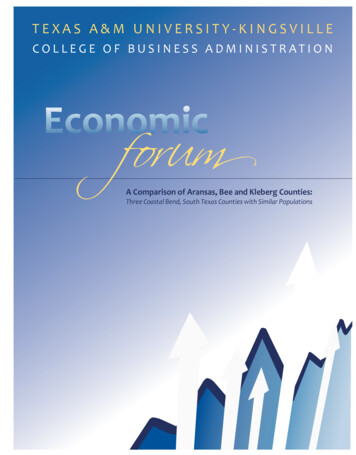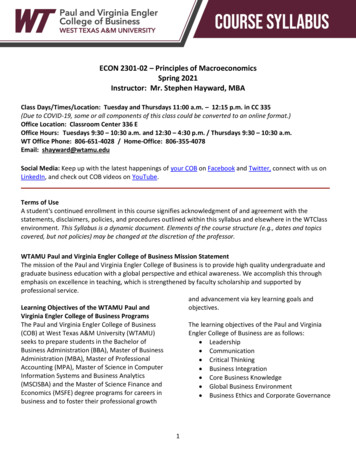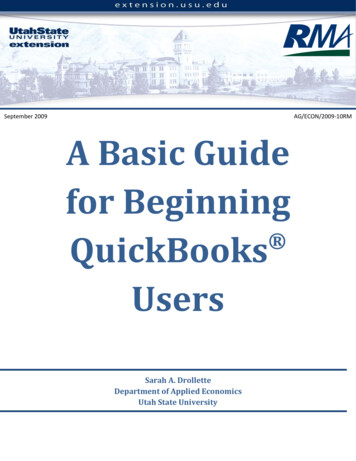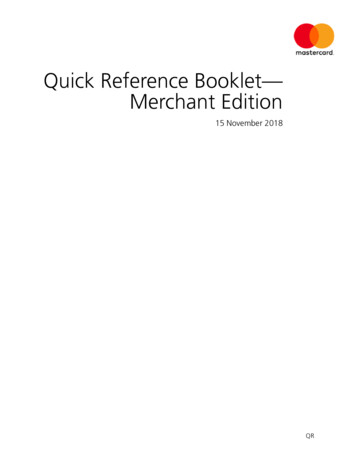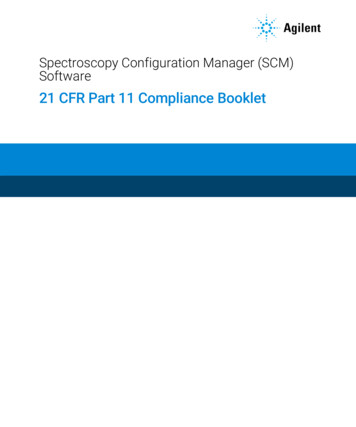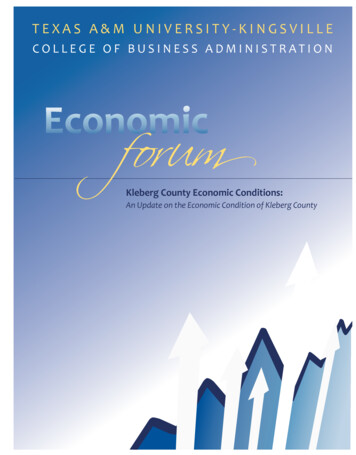
Transcription
TEXAS A&M UNIVERSITY-KINGSVILLECOLLEGE OF BUSINESS ADMINISTRATIONforumKleberg County Economic Conditions:An Update on the Economic Condition of Kleberg County
PresentersTheDr. Keith R. Phillips–Senior Economic and Policy Advisor at the Federal Reserve Bank of Dallas- SanAntonio Branch“An Overview of the Texas Economy”Dr. Phillips joined the Federal Reserve Bank of Dallas in January 1984. His areas ofconcentration include regional economics and economic forecasting. Dr. Phillipshas published numerous articles on the economy and other economic topics inDallas Fed publications and academic journals. Research Papers in Economics,which tracks publications in economics, ranks Phillips in the top five percent ofeconomists across the world in terms of the number of distinct publications. Heis a contributing member of the Western Blue Chip Economic Forecasting Group, where he has been the mostaccurate out of eight Texas forecasters for nine out of the past 16 years. His research and analysis has beencovered in media such as CNN, The News Hour with Jim Lehrer, USA Today, Business Week, the Wall StreetJournal, The New York Times, MSNBC and in media throughout Texas.In August, 1996, Dr. Phillips was transferred to the San Antonio branch in an effort to improve the regionaleconomic coverage of the Dallas office and to better serve the needs of the South Texas community.Dr. Phillips teaches courses in managerial economics and quantitative analysis in the Executive MBA programat UTSA. He obtained his Ph.D. in economics from Southern Methodist University and holds a B.A. and M.A. inEconomics and a Bachelor of Journalism degree in News/Editorial from the University of Missouri at Columbia.Dr. Thomas Krueger–Professor and Director of Faculty Research atTexas A&M University-Kingsville College of Business Administration“Kleberg County Economic Conditions:An Update on the Economic Condition of Kleberg County”Dr. Thomas Krueger is a professor and interim chair at the Department ofAccounting and Finance at Texas A&M University-Kingsville. He holds a DBA inFinance from the University of Kentucky, an MBA from Minnesota State University and a B.S. from University of Wisconsin-Eau Claire. Before joining Texas A&MUniversity, he taught finance at the University of North Carolina at Charlotte (1986-1989) and the University ofWisconsin-La Crosse (1989-2010). While at UW-La Crosse, he was chair of the Finance Department from 19931999 and Internship Coordinator for the East Central European Scholarship Program, finding and directing theinternship experience for 450 mid-level and higher managers from Eastern Europe. In 2010, Dr. Krueger taughtInvestments to members of the U.S. Army at the Fort McCoy installation.As Director of Research, Dr. Krueger monitors and assists other faculty in their research efforts. Over 60refereed journal publications have been authored by him, including original rigorous research leading to theidentification of the famous “Super Bowl Stock Market Predictor.” His research has been found in suchrenowned publications as the Journal of Finance, Journal of Accounting and Finance, and International BusinessResearch and Practices. While at UW-La Crosse, for over a decade, he provided semi-annual reports on theperformance of local companies, which were combined into a “7 Rivers Equity Index.” His presentationderives from this past experience.
forum& LuncheonSponsored by Kleberg BankTuesday, February 12, 2013, 11:30 a.m. - 1 p.m.Memorial Student Union BuildingBallrooms A&BLunch .11:30 a.m. - 12:00 p.m.Welcome and Introductions by Dr. Rick Aukerman . 12:00 - 12:05 p.m.Overview of Texas Economy by Federal Reserve Speaker Dr. Keith Phillips. 12:05 - 12:25 p.m.Questions & Answers Session.12:25 - 12:40 p.m.Overview of Coastal Bend Economy & Kleberg County by Dr. Thomas Krueger . 12:40 - 1:05 p.m.Questions & Answers Session.1:05 - 1:25 p.m.Concluding Remarks by Dr. Aukerman.1:25 - 1:30 p.m.Featured Speakers:Dr. Keith R. Phillips–Senior Economic and Policy Advisor at the Federal Reserve Bank of Dallas- San Antonio Branch“An Overview of the Texas Economy”Dr. Thomas Krueger–Professor and Director of Faculty Research at Texas A&M University-Kingsville“Economic Information on the Coastal Bend Countieswith a Narrow Focus on Kleberg County”Forum Agenda:Today we will be presenting a variety of economic indicators for our region. This project willprovide decision-makers with valuable tools for strategic planning. Data for the presentation has been gathered from the survey participated in online.
PurposeStatement ofThis report provides comprehensive documentation concerning regional economic indicators for KlebergCounty, Texas. The research is an ongoing analysis provided by the Texas A&M University-Kingsville College ofBusiness Administration. The first section examines a broad range of socio-economic, employment, andincome data. For instance, this section includes information about poverty levels, education levels, andsources of income in Kleberg County. Special attention is paid to the agriculture and government sectors ofthe local economy. The second section presents current businessmen and student opinions regarding keyeconomic factors. This project builds on the base of economic information provided first in 2012 and isexpected to annually expand upon our understanding of Kleberg County and thereby provide decision makerswith a valuable tool for strategic planning.Kleberg Bank sponsors this research in collaboration with the Texas A&M-Kingsville College of BusinessAdministration. Dick Messbarger (Economic Development Council) and Mike Kallem (Director of Development Services for Kingsville) provided input on the 2012 edition of this report. In addition, I want to thankMary Alice Wiechman and Harmeet Singh from the College of Business Administration and Julie Navejar fromMarketing and Communications for their assistance and feedback on this year’s report.Specific goals of this project include: Support business owners in their decisions by gathering key indicators of local economic vitality. Identify trends in order to ascertain the current situation in the dynamic nature of the economiccondition. Develop specific economic indicators for the region that are not readily available to decision makers. Act as a storehouse of these fundamental and trend insights. Develop tools to assess Kleberg County’s economic progress. At the outset baseline measures arebeing developed that will allow comparison with other regions and measure future economic growthof the economy. Only by knowing one’s current condition is it possible to gain an understandingregarding what the future holds. Bring academic and governmental professionals together with business owners for discussion aboutthe local economy and related critical issues. Create a business recruitment and retention tool by publishing this information.The 2013 ReportIn 2012, the College of Business Administration hosted the first Economic Forum. As part of that event, acomparison was made between Kleberg County, adjacent Brooks County and Jim Webb County, and the stateof Texas. Several unique factors make Kleberg County unique from even those counties that are close inproximity. Therefore, it was decided to analyze Kleberg County this year from a longer-term perspective. Thisyear’s presentation will take a long-run view of economic conditions in Kleberg County, examining trends ineconomic conditions. In some instances, data presented will reach back over four decades.A key source of information used in the first section of this report is the Economic Profiles System – HumanDimensions Toolkit (EPS-HDT). HPS-HDT is a free, easy-to-use software application that produces detailedeconomic and social demographic reports about counties, states, and regions. It uses statistics published byan array of government institutions, including the U.S. Department of Commerce (Bureau of Economic Analysis and Bureau of the Census), U.S. Department of Labor ( Bureau of Labor Statistics), and U.S. Department ofthe Interior (Bureau of Land Management and Forest Service). Uncited data was obtained from HeadwatersEconomics, an independent, nonprofit research group within the U.S. Department of the Interior’s Bureau ofLand Management which publishes EPS-HDT. Information about any U.S. county can be obtained at:www.headwaterseconoimcs.org/eps-hdt.
Table ofCONTENTSPart I. Kleberg County Economic ConditionsPopulationEducation & Poverty LevelsHousingEmploymentEmployee CompensationA Special Look at Two SectorsFigure 1. Population Trends in Kleberg CountyFigure 2. Population, Kleberg County Compared to Texas Non-MetroFigure 3. Median Age in 2000 & 2011Figure 4. Education Attainment in 2011Figure 5. Individuals and Families below Poverty in 2011Figure 6. Percent of Households Receiving Earnings, by Source in 2011Figure 7. Median Monthly Mortgage Costs and Gross Rent in 2011Figure 8. New Home Sales in Kleberg CountyFigure 9. Measures of HealthFigure 10. Employment Compared to Texas Non-MetroFigure 11. Monthly Unemployment Rate in Kleberg CountyFigure 12. Employment by Major Industry Category in Kleberg CountyFigure 13. Personal Income by Major Industry Category in Kleberg CountyFigure 14. Components of Personal Income in Kleberg CountyFigure 15. Inflow & Outflow of Earnings in Kleberg CountyFigure 16. Cash Receipts from Agriculture in Kleberg CountyFigure 17. Agriculture Employment in Kleberg CountyFigure 18. Percent of Total Jobs in Government in Kleberg County vs. U.S.in 2010Figure 19. Government and Non-Government Income in Kleberg CountyFigure 20. Government Jobs by Type in Kleberg CountyFigure 21. Government Income by Type in Kleberg CountyPart II. 2013 Economic Forum Survey ResultsFigure 22. Opinions Regarding Economic ConditionsFigure 23. Percentage of Participants Expecting Improvement over theComing YearFigure 24. Percentage of College Students Expecting Improvementover the Coming YearFigure 25. Extent to Which Participants View Various Local Institutions asBeing Supportive of BusinessFigure 26. Extent to Which College Students Perceive Various LocalInstitutions as Being Supportive of BusinessFigure 27. Average Ranking of Economic Concerns among ParticipantsFigure 28. Average Ranking of Economic Concerns among College StudentsFigure 29. Proportion of Survey Responses on which Economic Concern IsIdentified as Being Most ImportantFigure 30. Preferred Government Allocation of 100 in Additional Revenue
Part I. Kleberg County Economic ConditionsPopulationSteady, long-term growth of population, employment, and income is generally an indication of a healthy,prosperous economy. By comparison, an absence of growth or a long-term decline in these measures isconsistent with a struggling economy. Economic growth can benefit the general population of a place,especially by providing economic opportunities.The estimated population of Kleberg County at year-end 2011 was 32,196. A graphic depiction of the growthand decline of Kingsville’s population since 1970 is presented in Figure 1. Kingsville’s population was threepercent higher in 1970 than 42 years later. During the interim, there were two population peaks, one in theearly 1970s and the other in the early 1980s. In 1980 the population was 33,508, its highest U.S. census Fig. 1: Population Trends in Kleberg CountyFig. 2: Population, Kleberg County Compared to Texas cessionKleberg Co., TexasTexas Non-Metro
Kingsville has been left out of the general growth in population across the United States. Over the past fourdecades (i.e., from 1970 to 2010), while the U.S. population grew by 52 percent, Kingsville’s populationdropped by a little over three percent. Over the more recent 2000-2011 period, local population growth hasbeen a positive 0.9 percent. Though positive, it is still dwarfed by the nine percent average across theUnited States. When limiting the comparison to non-metro areas of Texas, as shown in Figure 2 on theprevious page, the relative lack of population growth becomes even more apparent. For every 100 citizensin non-metro Texas locales in 1970, there were 200 citizens by 2009. By comparison, the blue line representing Kleberg County is virtually flat.Unlike the “aging of America” phenomena that is widely reported, Kleberg County it actually gettingyounger. The median age of Kleberg County residents fell slightly from 29.2 years to 28.8 years, as shown inFigure 3. In contrast, the median age across the United States rose to 37.0 years. One explanation for thelack of an aging aspect of the Kleberg County population is the source of population growth. During the2000-2011 period, over three times as much local growth is attributed to migration. Nationally, only 13percent of population growth is due to migration, while the local proportion is 39 percent.Fig. 3: Median Age in 2000 & 201140353037.035.329.228.82520151050Kleberg County, TexasMedian Age (2000)U.S.Median Age (2011)Education & Poverty LevelsEducationThe difference in migration patterns may be correlated with the differences observed in education patterns.Specifically, as shown in Figure 4, almost twice as many citizens above the normal age of graduation do nothave a high school degree. Almost a quarter of the eligible population does not possess a high schooldiploma or equivalent. At the other end of the education spectrum, six fewer citizens per hundred,[i.e., ( 0.282 – 0.217) X 100] possess a college degree. Given the fact that Kleberg County is the home to TexasA&M University-Kingsville, the percentage of non-university affiliated citizens without a university degree iseven more dissimilar to the national norm.
Fig. 4: Educational Attainment in 201130%25%28.2%24.3%21.7%20%14.6%15%10%5%0%Kleberg County, TexasNo High School DegreeU.S.Bachelor’s Degree or HigherDoing well in college requires the ability to communicate. The fraction of citizens in Kleberg County unableto communicate effectively in English is almost fifty percent higher than found nation-wide. Across theUnited States, 8.5 percent of the adult population speaks the English language less than “very well.” InKleberg County, this percentage balloons to 12.5 percent. Or stated another way, one out of every eightadults in Kleberg County have difficulty communicating in English, versus one out of every 12 across theUnited States.With limited education and ability to communicate in English, it is not surprising that the percentage ofKleberg County residents in poverty far outstrips the national average. As shown by the left bar inFigure 5, one in every four local residents lives in poverty. Nationally, the percentage is only one out ofevery seven, or 14.3 percent. When it comes to families, the difference is even more stark with 17.4 percentof families in poverty locally, compared to 10.5 percent nationally. These bleak statistics overlook the costof living in a given region. Fortunately, the cost of living in Kleberg County is 83 percent of the nationalaverage ving), reducing the impact of a lower income.Fig. 5: Individuals and Families Below Poverty in 201130%25%20%24.8%17.4%14.3%15%10.5%10%5%0%Kleberg County, Texas*People Below PovertyU.S.*Families Below Poverty
Poverty statistics do not segregate those who are living on government assistance from those who have alow income because they are dependent upon their pensions and social security checks for income. Figure 6clarifies the picture of poverty in Kleberg County, by reporting the source of household earnings. More thanthree-fourths of Kleberg County residents receive earnings from labor. Obviously, some of these citizens alsoreceive social security checks, because that occurs in over one-fourth of the households. Approximately, onein six households is getting retirement income. In addition to the poor, supplemental security incomesupplies benefits to the blind and disabled. Food stamps, or the supplemental nutrition assistance program(SNAP), serves about one in six households.Cash public assistance requires a minor (or pregnant woman) in the household. A family of four earning 851will receive a subsidy of 507 (http://www.ohiolegalservices.org/public/legal problem). Kleberg County hasabout 10 percent more households on food stamps than the fifteen percent found across the mericans-food-stamps-980690).Fig. 6: Percent of Households Receiving Earnings,by Source in 201178.0%28.2%16.4%Food Stamp/SNAP1.6%Cash PublicAssistance Income6.3%Supplemental SecurityIncome (SSI)Retirement IncomeSocial Security (SS)16.7%Labor Earnings90%80%70%60%50%40%30%20%10%0%HousingA good example of the lower costs found in Kleberg County can be observed through an examination ofhousing costs, as presented in Figure 7. At 633, median monthly mortgage costs in Kleberg County are abouthalf the national average. Median gross rentals are also lower locally, at 651 versus 871 nationally. Thetendency of Kleberg County residents to be students and military employees, and therefore temporarily inKleberg County, is illustrated by the relatively higher median rentals, compared to mortgage costs. Unlike thenational situation, in Kleberg County the orange bar (mortgage cost) is shorter than the gray bar (rental cost)in Figure 7.
Fig. 7: Median Monthly Mortgage Costs and Gross Rent in 2011 1,500 1,148 871 1,000 633 651 500 0Kleberg County, TexasMedian Monthly Mortgage CostU.S.Median Gross RentAnother way to measure housing expenditures is the consideration of housing cost as a percentage ofincome. Recall from above, that income is relatively low in Kleberg County. Consequently, despite the lowhousing costs, it is not surprising that approximately the same percentage of income is spent on housing.Specifically, in Kleberg County 34 percent of homeowners spend more than 30 percent of household incomeon mortgage payments, while the percentage across the United States is 37 percent.Fig. 8: New Home Sales in Kleberg CountyCount140Price 140,000120 120,000110 110,00080 80,00060 60,00040 40,00020 20,0000Q1 Q2 Q3 Q4 Q1 Q2 Q3 Q4 Q1 Q2 Q3 Q4 Q1 Q2 Q3 Q4 Q1 Q2 Q3 Q4 Q1 Q2200720082009201020112012 0Cost ofHome SalesPer QuarterMedian Price
Approximately 41 percent of Kleberg County renters spend over 30 percent of household income on rent,while across the United States, the percentage is 48 percent. Apparently, those who are renting in KlebergCounty earn a relatively higher income and consequently are in a better position to pay the higher rents,while homeowners are in a worse position to pay for even their relatively modest housing.Talking about housing, city-data.com puts out a very interesting comparison of house sales and house pricesacross time, which is presented in Figure 8 on the previous page. The red line in this graph illustrates theerratic, but positive trend in new home prices. The highest average new home price is the most recent onewith an average exceeding 130,000. Simultaneously, the number of new homes sold has been in a generaldecline over the 2007-2012 period. During the second quarter of 2007, more than 100 new homes were sold.Whereas, during the second quarter of 2012, one-tenth as many were new residences s
Dr. Phillips teaches courses in managerial economics and quantitative analysis in the Executive MBA program at UTSA. He obtained his Ph.D. in economics from Southern Methodist University and holds a B.A. and M.A. in Economics and a Bachelor of Journalism degree in News/Editorial from th
